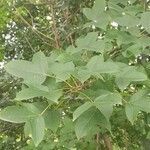Trees to 30 m tall, trunk sometimes 1 m in diam.; bark gray-brown; branchlets pubescent or glabrous, somewhat lenticellate; buds ovoid, 1 cm, puberulent. Stipules red, nearly free or adnate to petiole, 1–1.4 cm; petiole 8–12 cm, pubescent; leaf blade broadly ovate, palmately 3-lobed and 3-veined, central lobe longer, abaxially usually drying gray-white, pubescent or glabrous, base rounded, margin glandular serrate, apex caudate-acuminate, cordate, subcordate or truncate, veins prominent on both surfaces. Male inflorescence a short spike, several arranged in a raceme. Female inflorescence 24–43-flowered; peduncle 3–6 cm, occasionally lenticellate, eglandular. Male flowers: stamens many, filaments unequal, anthers slightly shorter than filaments. Female flowers: staminode teeth 4–7, needlelike, 4–8 mm; ovary pubescent, styles 6–10 mm, usually coiled backwards. Infructescence globose, 3–4 cm wide. Capsules with persistent staminodes. Seeds many, brown. Fl. Mar–Jun, fr. Jul–Sep.
More
A deciduous tree. It grows 18 m high and spreads 9 m wide. It can grow 40 m tall. The trunk is straight. The tree is broadly cone shaped. The bark is grey-white and becomes darker and cracked with age. The leaves usually have 3 lobes. The leaves are 13 cm long by 15 cm wide. The lobes taper to a point and have rounded teeth. The leaves are purple when young and become dark green before turning red to purple in autumn. The leaf stalks have a red tinge. The fruit are small and in clusters are 2.5-4 cm across.
Can be grown by cuttings or seedlings. Seeds needs stratification.


